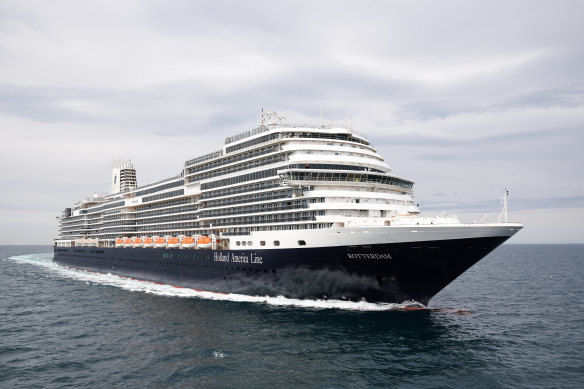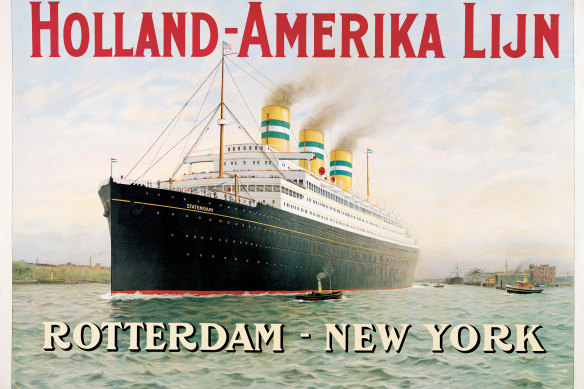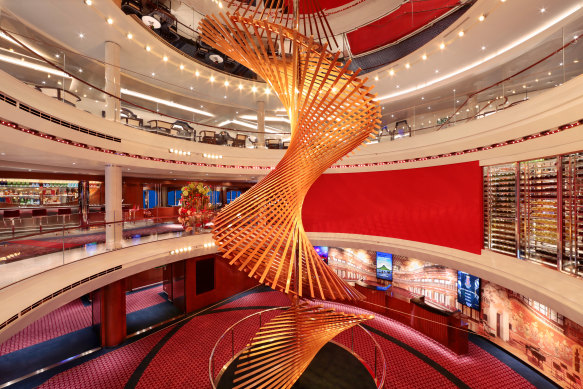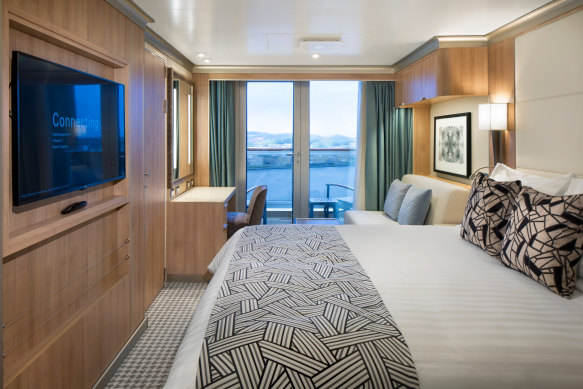From straw mats to luxury cabins: How cruising transformed over 150 years
By Jill Dupleix
I’m sitting up in bed at the Hotel New York in the Dutch port city of Rotterdam, reading about the history of the Holland America Line.
The company formed in 1873 as the Dutch American Steamship Company, but soon became known by its two ports of embarkation and disembarkation – Holland and America. The building in which I am about to fall asleep was the shipping line’s official headquarters from 1901 to 1977, so its majestic rooms, broad stairs, and oriel windows have borne silent witness to the hopes and dreams of hundreds of thousands of people drawn here to be transported across the ocean.
Downstairs, the vast, wood-lined restaurant – the perfect spot for a hot chocolate and a huge wedge of cinnamon-scented apple cake – would have been filled with milling passengers and their luggage, with anxious queues at the ticket office, now the hotel reception.

Holland America’s MS Rotterdam, the seventh ship to bear the name.
From my bedroom, I can see Holland America’s newest Rotterdam, the seventh liner to carry the historic name, moored at Wilhelmina pier; its 1048 crew members getting everything sparkling for the 2668 incoming passengers. Tomorrow, my luggage will be magicked away and I will stroll on board to a luxurious cabin with verandah balcony, en-suite bathroom and king-size bed.
It feels in stark contrast to the experience of early passengers, who arrived by rail, river-boat and on foot, ready to board the first ship to bear the name Rotterdam, in 1872. It was tiny, only 82 metres long, with just 44 crew and 70 passengers.
Before boarding, the emigrants had to buy their own straw mattress on the dock, as there was a great fear of plague and disease entering the United States from Europe. Their baggage was inspected, and any spoiled edibles or mildewed clothing was removed and destroyed (onions were often found, due to the popular fallacy that eating raw onions helped prevent sea-sickness). The used bedding was collected and burnt on arrival in New York.

A vintage poster from 1914.
There were other transatlantic shipping lines (Cunard, for instance, had been sailing from England since 1840) but right from the start, the Holland America line had an edge: the tremendous seagoing heritage of the Dutch, recognised throughout Europe.
Demand grew and the fleet expanded; each new steamship allowing more room for passengers, and less space for freight (tulip bulbs and bottles of Dutch gin). First class passengers grew from just a handful, to around 300 on each voyage, and by the start of World War 1 in 1914, the line was running a weekly service to New York with all of its six liners.
This, then, is the origin story of cruising as we know it, as cabin design, onboard catering and cabin service were redesigned and streamlined to service guests – who weighed much less than freight, and were therefore more profitable to the company.
At the peak of transatlantic voyages, between 1900 and 1920, about 12.5 million Europeans crossed the Atlantic, and the Holland America line carried over 1 million of them. Actor Johnny Weissmuller immigrated to the US on a Holland America ship, as did Herbert Hoover, Cary Grant, Katherine Hepburn, Clark Gable, Louis Armstrong and Albert and Elsa Einstein. As the Rotterdam’s cruise director Karlijn Verpalen has it, “Billy Crystal’s grandfather immigrated on one of our ships, so if it weren’t for us, Harry would never have met Sally.”

The MS Rotterdam of today bears little resemblance to its namesake from a century ago.
On April 3, 2023, the Rotterdam VII left Fort Lauderdale in Florida with a very special mission, to sail into the port of Rotterdam on April 18, the precise day of the 150th anniversary. Official celebrations were, of course, held in the Hotel New York, where the line’s president, Gus Antorcha welcomed Dutch royalty, descendants of the founders of the line, and, very much to one side, me.
Rotterdam’s lord mayor, Ahmed Aboutaleb, had the city’s famous Erasmus Bridge emblazoned in a light show for the occasion, and Her petite Royal Highness, Princess Margriet of The Netherlands anointed a commemorative ship’s bell with champagne, a tradition usually reserved for the launch of a new ship.
“The fabric of history is woven from the threads of millions of stories, and at the heart of each of those stories is a person,” said Gus Antorcha from the stage. “I hope that decades from now, those who come after us will gather on this very spot at Hotel New York to share them.”
As a finale, the officers of the Rotterdam VII paraded along a replica of the ship’s deck, throwing colourful streamers over the railings and into the audience as if about to sail off to the New World.

The modern comforts of a stateroom on board.
In reality, the ship set sail the following day into the old world, on a five-day itinerary criss-crossing the North Sea from Oslo, to Copenhagen, to Amsterdam. From there, it embarked on its first itinerary to Scotland, stopping at Inverness (Loch Ness, fairytale scenery, castles), and Edinburgh (fruit cakes, Military Tattoos, more castles).
The on-board experience has, of course, changed out of sight. The ‘tween decks, or steerage, was particularly uncomfortable 150 years ago, for a voyage that would take 15 days or longer, depending on weather conditions. Men were separated from women and children, and contained in low-ceilinged cabins of six to twelve bunks, with just one hour of perambulation allowed each day.
Historian Bill Miller says that one writer of the time described the lower-deck passengers as “cheerful, hopeful and optimistic about their future, entertaining themselves with music and dancing.”
There were also three square meals daily (as there are now) taken on long wooden tables in the mess hall. These ranged from little more than chunks of hard bread and tureens of soup or beans, to meals of sauerkraut, smoked bacon and potatoes that finished with plum duff, a precursor to Christmas pudding. First class passengers had more elevated fare, such as oysters on the half shell and seared duckling, before the gentlemen retired to the Smoking Room.
In a great innovation for the time, their quarters were cleaned while passengers were busy dining (much as the staterooms are serviced today, by vigilant stewards). There was one very good reason for that: getting the passengers to New York in a healthy condition. Third class steerage passengers were rigorously inspected by doctors at the infamous Ellis Island before being cleared to enter the country – and if anyone was rejected on health grounds, Holland America had to pay for their return sailing to Europe.
The anniversary celebrations will continue until the end of 2023, spread across every sailing of Holland America Line cruise ships, with beautifully produced “origin story” presentations in the main theatres.
Each voyage features its own 150th Gala Dinner, and – in one of the most popular initiatives – daily throw-back Happy Hours, with the original prices (as low as 75 cents) on commemorative cocktails. I can personally vouch for the fact that the limited edition HAL Pilsners specially brewed for the anniversary go down a treat with a burger by the pool; and the exclusive bottling of De Lijn Gin makes the perfect sundowner taken on your stateroom balcony.
Be warned, each itinerary also designates one evening for an Orange Party, at which passengers are encouraged to wear the Dutch national colour, in honour of the historic royal House of Orange. Fluorescent orange evening dresses, feather boas and dinner suits are not uncommon, but if orange is just not your colour, it’s perfectly acceptable to wear just a scarf or even ear-rings in the designated shade. My husband and I packed a couple of suitable accessories, then inadvertently missed the celebrations entirely. (Anyone want to buy a very bright orange, good-as-new tie, going cheap?)
The average passenger on a cruise will quite happily embrace all it has to offer without even thinking of the centuries of maritime exploration, engineering and innovation that made their oceanic holiday possible.
But when a company such as the Holland America line celebrates 150 years of sailing in style, it’s worth pausing to reflect and celebrate. Long known as ‘the bridge across the ocean’, the line has also become a bridge from the past to the future.
On that first evening on board, I head for the Ocean Bar and settle in with the signature Martinez, a cocktail that dates to 1884. I might only have a seven-day jaunt across the North Sea ahead of me, but I raise my glass to all those who have gone before, bravely sailing to a new life in a new world.
The writer travelled as a guest of Holland America Line.
THE DETAILS
CRUISE
Holland America Line’s 7-day Scandinavian Fjords & Capitals sails on May 4 and June 29, 2024. It costs from $1864 a person in an Inside suite, twin share. The Verandah stateroom costs from $2314 a person, twin share. See hollandamerica.com
FIVE FUN FACTS
EATING HISTORY
The menus on every Holland America cruise voyage in 2023 feature classic dishes from the line’s historic sailings, chosen and developed by Director of Culinary Operations, John Mulvaney. Highly recommended: the Chopped Sirloin Steak with sauce Robert, green peas and swiss potato, inspired by the meat-loaf like Hamburg steak introduced to the US in the late 19th century by German immigrants.
THE GRAND DAME OF CRUISING
The Rotterdam V holds a special place in cruising history, beginning a yearly tradition of circumnavigating the world in 1961. “It was like a floating clubhouse”, says Cruise Director Karlijn Verpalen. One passenger packed 300 dresses for the 95-day voyage. Another reserved two suites; one for her, and one for her artworks. Then there was the female passenger who travelled with her own cosmetic surgeon. She left for a three-month cruise, only to return looking 20 years younger.
SLEEPING BEAUTY
In 2008, the retired SS Rotterdam V was converted to a floating hotel, permanently moored in Rotterdam. As the SS Rotterdam by Westcord, her 576 cabins have been transformed into 254 rooms, with themes of Manhattan, Bahamas, or Original. Guests can enjoy the spirit of travelling in the 1950s, without actually having to return to the 1950s. Or, indeed, go anywhere. See ssrotterdam.com
POLES APART
In January 2025, Holland America will sail what is believed to be the world’s first Pole-to-Pole round trip from the US. On the 133-day Grand Voyage, the Volendam will visit five different continents, from Antarctica in the south to the Arctic Circle in the North. Highlights will include sailing through the Panama Canal, Cape Horn, the Amazon River, Norwegian Fjords, and earning some very big bragging rights. See hollandamerica.com
THE WORLD’S OLDEST CRUISE LINES
P & O Cruises have been around for so long, few people know what the initials stand for (Peninsula & Orient Steamship Company). Generally regarded as the world’s first dedicated cruise line, it sailed from Southampton, England to Malta, Gibraltar and Athens in 1837. Britain’s Cunard Line pioneered the transatlantic passenger service in 1840; then came Germany’s biggest shipping company Hapag-Lloyd (formerly Hamburg-Amerika) in 1847, Holland America Line in 1873, and Norway’s Hurtigruten in 1893. Still sailing, after all these years.
Sign up for the Traveller Deals newsletter
Get exclusive travel deals delivered straight to your inbox. Sign up now.